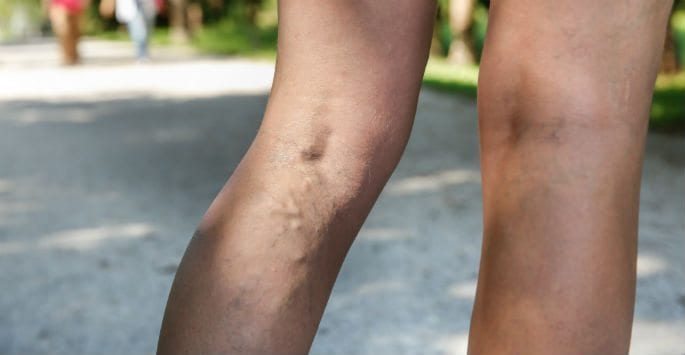Varicose veins develop more frequently in the legs than anywhere else in the body. They are often visible through the skin and can also bulge out from the surface of the skin.
Veins serve the purpose of returning blood to the heart and lungs in order for it to be oxygenated again after circulating through the body. In order for the blood in the legs to be returned to the heart, it must be pumped against the flow of gravity.
To help keep the blood flowing in the right direction, veins contain valves that act as check valves to prevent a backwards flow. If these valves fail to function as they should, blood can begin to pool in the veins. This happens when the natural pumping action is working against the backwards flow allowed by the faulty valves. This increases the amount of pressure exerted on the walls of the vessels, causing them to enlarge and become varicose.
The likelihood for developing varicose veins increases with age. This is because blood vessels lose elasticity over time and can begin to stretch. The stretching can have an effect on the valves and that blood can begin to flow backwards, bypassing the valves. Because the blood that pools inside varicose veins is deoxygenated, the veins frequently appear blue.
Women are more likely to develop varicose veins than men. This is due to hormonal changes that occur during conditions such as pregnancy, premenstruation and menopause. The hormones tend to relax the vein walls. Consequently, hormone replacement therapy or the use of birth control pills can increase the chances of developing varicose veins.
The tendency to develop these veins can also be hereditary. If other members of your family have the condition, it is more likely that you will develop varicose veins at some point in your life as well.
Obesity is another risk factor for the development of varicose veins. This is because added pressure is placed on the veins by the additional body weight.
If you have an occupation or lifestyle that results in standing or sitting in the same position for long periods of time, your chances of forming these veins will increase. In these situations, you should make it a part of your normal routine to move around frequently and minimize the amount of time spent in a stationary position.
If you have varicose veins and are concerned with their appearance, or if you are having symptoms such as pain, aching and cramping, you should have a conversation with the team at Canada Vein Clinics about treatment options. Fortunately, there are various methods available to remove varicose veins that do not require a stay in the hospital or lengthy downtime.
During a consultation at Canada Vein Clinics, our professionals can evaluate your condition, review your medical history and make a recommendation as to the type of treatment that is likely to bring you the greatest level of success. We have offices in Toronto, Richmond Hill, Vaughan, Ottawa, Kanata, Orleans, Kawartha Lakes, Halifax, Dartmouth and Moncton. Contact us today to book an appointment!



